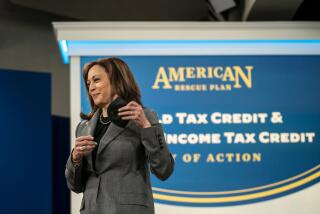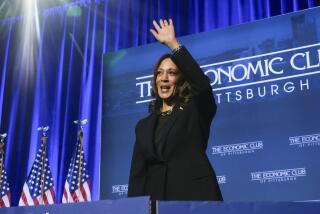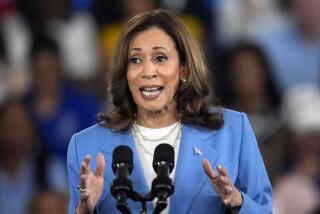Many Different Budget Pieces--How Do They All Fit Together?
The t est of a plan isnât whether itâs called new or dazzling.... The only test is: Is it sound and will it work? George Bush, State of the Union, Jan. 28, 1992. Will the Presidentâs economic initiatives meet the test? Certainly everyone should hope so.
Some of his proposals may help a recessionary America in the short term. But overall his economic plan does little to address formidable long-term economic problems that will persist well after the recession ends.
President Bushâs successful foreign policy initiative--the end of the Cold War--is causing painful realignments in jobs and industries on the home front. He has the rare opportunity to come up with a blueprint for a new economic order at home. Instead he has offered a hodgepodge of tax cuts, incentives and spending cuts--Band-Aids to hold the economy together.
THE OPPORTUNITY: What about the big picture for the future? Past presidents have set forth their economic visions. When he faced economic troubles during his Administration, John F. Kennedy laid out major 1962 tax cuts for machinery and equipment during his State of the Union address. Such a presidentially driven program was credited with helping to get America moving again during difficult economic times.
The Bush approach was far from grandiose, to be sure. The Presidentâs $1.5-trillion budget for 1993, released the day after his State of the Union address, is peppered with a varied mix of tax measures to pump money into the economy. Most are short-term hits designed to stir the economy without overheating it. Nothing wrong with that.
But he offered little new, except for change in the withholding tax rates--a move with which the President can proceed without approval from Congress. The change would allow each taxpayer, on average, to reduce his or her annual tax withholding by $350 a year, or $7 a week.
Other short-term tax cuts and incentives are directed at real estate and construction. Bush is looking to these two sectors to fuel economic growth.
Local housing markets and owners could benefit the most. First-time home buyers stand to benefit. Bush is calling for a tax credit of up to $5,000 for first-time home buyers. In California, that should help as many as 166,000 first-time home buyers get into houses and condos. To help them with their down payments, the President has proposed allowing painless withdrawals of up to $10,000 from Individual Retirement Accounts.
Though housing is very important, Bush has proposed a host of other real-estate-related tax measures that appear to prop up commercial real estate and reopen loopholes closed in the 1986 tax reforms. Perhaps this will help, but the overhanging worry is that wanton real-estate lending during the 1980s led to bad loans and became a major reason for the current credit crunch and economic slump.
The President has recycled his proposal to cut the capital gains tax. It has been one of his few but consistent economic initiatives, but it is unclear whether it might trigger meaningful investment in productive industries--or just more hyperinflated stock market âchurn.â
Bush is exercising his executive authority by imposing a 90-day moratorium, at the Cabinet level, on new federal regulations that would allegedly limit economic growth.
But the President should remember that if regulations are bad they are bad not just for 90 days, and should be junked entirely; conversely, if they make sense they shouldnât be shelved even temporarily.
THE WORRY: Even though Bush has rightly proposed some business investment tax credits, overall he failed to set forth an integrated plan to spur long-term investment, savings and job creation.
The cutbacks in defense are of course necessary, but he proposed no means or plan to offset the loss of thousands of jobs in the defense and aerospace industries. California alone might lose 200,000 jobs because of the defense cutbacks.
He also did not address capital formation problems. Business and consumers need access to money to start new businesses or buy homes. Lower interest rates are helping, but banks in particular must be freed of old Depression-era laws so they can expand into other financial services.
Health care costs are a major financial drain on consumers and business. The Presidentâs proposal for a tax credit for low-income Americans is fuzzy and ill-defined at best. It appears to do little to solve the fundamental problem in health care: skyrocketing costs. Dollars spent on health care take away from the nationâs productivity and affect U.S. competitiveness. The President offered little new in education or the environment. And he said little about the deficit. It will rise to a record $399.4 billion this fiscal year.
THE CHALLENGE: Though some of them make more sense than others, many of the different pieces in the Presidentâs economic game plan can be fairly well-defended. What is puzzling is how all the pieces fit together. On one hand the Bush approach simply reflects the long-held Republican belief that the best cure for an ailing economy is to keep government intervention from making it worse. But the economy is so bad now that even the President must be having second thoughts about whether the famous âinvisible handâ of the unfettered market is going to right all wrongs. Thatâs why The Times recommended months ago that the White House convene a Camp David domestic summit on the economy, for the President to hear out sharply conflicting, expert economic advice. Tuesdayâs State of the Union--however well-delivered, however sincere--reflects a lot of little parts that in the end donât add up to enough of a whole. The White House--and the country--still needs such a summit brainstorming session.
More to Read
Get the L.A. Times Politics newsletter
Deeply reported insights into legislation, politics and policy from Sacramento, Washington and beyond. In your inbox three times per week.
You may occasionally receive promotional content from the Los Angeles Times.










